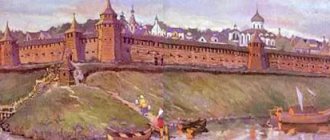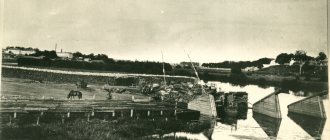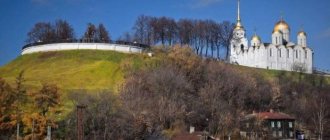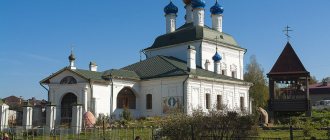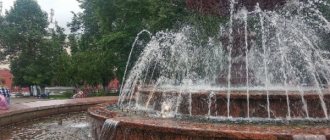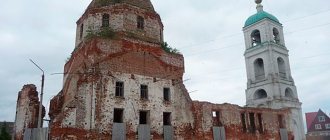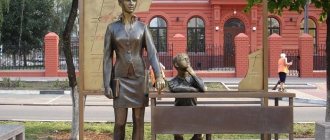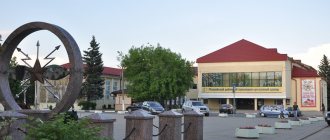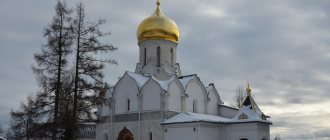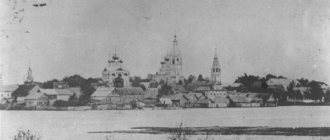Pokrov: areas, recreation, excursions, museums and churches, cuisine and restaurants, shopping and shops, attractions of Pokrov.
- Last minute tours
to Russia
Russia is rich in iconic cities. We have a city of bells, felt boots, samovars, irons, and then there is a “chocolate” city. Although Pokrov received his unofficial title not so long ago, it was his relationship with the beloved sweet that brought him fame. Now the chocolate bar is the same symbol of the city as the image of the golden cover on its coat of arms.
The city's coat of arms is divided into two parts: in the upper part there is the coat of arms of the entire Vladimir region - a crowned lion, in the lower part - the symbol of the city - two hands holding a golden cover.
The history of the city began in the 16th century, when the monastery of the Intercession Anthony Hermitage was located here. The monastery grew, and the settlement around it grew. Pokrov is the only city in Russia whose population has always increased, although it has not crossed the line of 20 thousand people. The city developed, turning from a monastery into an industrial one, until in the 90s it embarked on its “sweet” path. In 1997, the first German confectionery factory opened here.
Historical and ethnographic park-museum “Russian Island”
In the vicinity of the city of Pokrov, near the village of Zheludevo, there is a museum and folklore complex that is very interesting for lovers of Russian and Slavic history.
It was originally conceived and continues to develop as a monument to old Russian peasant life. On the territory of this complex you can visit an old-style peasant farmstead; in a village shop; pottery workshop; forge; carpentry workshop, handicraft spinning and weaving; on the cutting farm; mill; brewery; at the fishing and hunting camp and at the military compound.
Historical and ethnographic park-museum “Russian Island”
All visitors to the museum complex are offered master classes on crafts and rural technologies; classes in Russian fist fighting, educational and entertainment programs on the topic of environmentally friendly and healthy lifestyle in the countryside. Concerts are held with the participation of guslar players and storytellers. In the evenings, folk entertainments are held for tourists - parties, outdoor games, heroic fun, etc.
Location: Zheludevo village.
Folk traditions of the Feast of the Intercession of the Virgin Mary
Dmitrov: attractions, what to see in one day
In folk tradition, the time of weddings began with Intercession - after the harvest, when the main field work was completed, there was enough time and food for refreshments. Therefore, the Feast of the Intercession is considered the patron saint of weddings, and it was like a girl’s holiday. The brides tried to go to the service on this day, light a candle in front of the image of the Intercession of the Virgin Mary, and there was confidence that the girl who lit the candle first would get married before anyone else.
Hence the popular saying: “Pokrov-holiday, cover the earth with snow, and my head with a crown.” From that time on, the girls organized evening gatherings with handicrafts.
It was also believed that from this time winter begins, the first snow falls, covering the ground. They started heating the stoves, caulking the huts, and “feeding” the cattle for the winter. On this day, the last sheaf from the last strip, which was called the “reaper,” was given to the cattle. During the grain harvest, this sheaf was certainly eaten by the whole family, and then stored in the front corner of the hut until the Intercession. On this day, it was fed to the cattle, thereby hoping to protect them from winter lack of food and all the misfortunes that could lie in wait during the most difficult and severe time of the year.
Museums
Volokolamsk: attractions, what to see in one day
The sights of Intercession are not limited only to monasteries and cathedrals. We must not forget about the chocolate museum, which became the hallmark of the town relatively recently. It was founded in March 2004 and occupies a small area in the same building as the local Museum of Local Lore.
In several halls on the first floor you can see the development of the chocolate industry, and on the second floor you can see the historical appearance of Pokrov, which is not always possible to see while walking. Many elements remain invisible to the eyes of tourists, and therefore there is no better place to get acquainted than the museum.
It is worth noting that by purchasing one ticket, a tourist has the opportunity to appreciate the city not only from the historical side, but also from the chocolate side. In the museum rooms you can hear stories of the development of the chocolate industry, which has developed over several millennia.
A tourist will definitely see a showcase with a popular scene: Indians busy grinding cocoa beans. It is believed that they were the ones who contributed to the development of this direction. The Indians introduced the world to chocolate, taught how to make it and enjoy it. The second exhibition hall contains exhibits dedicated to the development of the sweet industry in the region itself.
Thanks to the efforts, the city was able to become famous for such a museum. In 2003, a competition was held for beginner tourist exhibits, where a simple provincial chocolate museum took first place. After 7 years, management decided to carry out a complete modernization. Even today, the Pokrov chocolate museum is considered one of the most innovative, since the designers used Smart Home technology.
As mentioned earlier, the Local History Museum is located in the same building as the Chocolate Museum. Of course, its size is not so large, but all the exhibitions are quite informative. In small rooms you can see retro items that date back to Tsarist times. Exhibits displayed on shelves help to understand the city through its rich history.
In one of the halls the atmosphere of a typical Pokrovsk hotel has been completely restored. Merchants who were heading to or from the capital could not only relax comfortably, but also enjoy classical piano music. Within the museum walls, a corner of the Postal Station was recreated, where prisoners on their way to the Vladimir Central Station stayed.
The sights of Pokrov have a long history. Anyone who wants to touch the historical side should definitely visit the Museum of Local Lore.
Transport
Murom attractions what to see in one day
An extensive network of bus routes is something that Pokrov can rightfully be proud of. You can get by this type of transport not only from one end of the city to the other or to the suburbs, but also to neighboring settlements: Orekhovo-Zuevo, Gus-Khrustalny, Murom and, of course, to the capital of Russia. Electric trains also go there, passing through the Pokrovsk railway station (located 4 km from the city in the village of Staroye Perepechino).
It is more difficult to find bicycle rentals here; only hotels can offer at least some choice. But there are plenty of places for riding, although these are not equipped bike paths, but mostly forest paths and park alleys. There are few taxi services in Pokrov, but the prices are reasonable. A trip around the city will cost 80 RUB.
Hotels
Sights of Yalta in one day: what to see
For city guests there are several options for staying overnight if their stay in Pokrov lasts more than 1 day. Accommodation options suit different budgets.
Complex "Podvorye"
At the address st. Lenina 210 (p. 2) there is a complex made in Russian style. All houses are located in a forest area. Guests can go hiking or hunting here, and the staff often organizes excursions to local attractions.
Guests can take advantage of free parking, bar and restaurant services, and free Wi-Fi. The rooms are heated, have flat-screen TVs, air conditioning, and the bathrooms have bathtubs or showers and a hairdryer.
| Category | Double accommodation (RUB) |
| Budget double | 1500 |
| Double | 2000 |
| Cottage | 2500 |
Best Hotel
The hotel is located on the street. Oktyabrskaya, 111. The hotel has a common recreation area, guests can use the parking, kitchen and reception at any time of the day. There is free Wi-Fi on site. Each room has a desk, TV, and private bathroom.
| Category | Double accommodation (RUB) |
| Family room (+shower) | 600 – 800 (depending on the number) |
| Shared room | 800 |
| Sleeping area | 300 (for 1 person) |
Hotel "Lost World"
The hotel is located in the village. Vvedenskoye, near Pokrov (Zelenaya St., 6). Guests have the opportunity to use the living room and kitchen. There are food delivery services to your room.
There is free Wi-Fi on site. There is private parking available for an additional fee. Each room has a wardrobe, TV, refrigerator and bathroom with shower, hairdryer and toiletries.
| Category | Double accommodation (RUB) |
| Double room with separate beds | 1900 |
| Deluxe with Balcony | 2000 |
| Deluxe | 2000 |
| Superior Family | 2600 |
| Single | 1600 (for 1 person) |
Hotel "Seventh Heaven"
The hotel is located on the street. Lenina, 40. Each room has a cable TV, private bathroom, wardrobe, air conditioning and free wi-fi. The rooms also include a refrigerator. The price includes breakfast according to the a la carte system.
| Category | Double accommodation (RUB) |
| Standard | 2800 |
| Economy with twin beds | 3200 |
| Economy with 1 large bed | 3200 |
| Junior Suite | 3400 |
| Large double | 3900 |
| Lux | 4200 |
Hotel Edem
| Category | Double accommodation (RUB) |
| Standard with large bed | 3000 |
| Standard with twin beds | 4000 |
| Junior Suite | 4000 |
| Deluxe | 4500 |
| Lux | 5000 |
| Executive Suite | 7500 |
| Standard 4-seater | 4400 |
Where to eat
After long walks around the city, tourists may feel the urge to have a snack. This can be done in one of the best cafes or restaurants in the city.
Pokrovsky miller
The cafe is located on the street. Lenina, 119. It serves traditional Russian cuisine, but also has a European menu and dishes for vegetarians. There is an opportunity to have a snack on the veranda. Visitors note that the staff is friendly, the prices are affordable, and the atmosphere is cozy. The average bill is 1500-2000 rubles.
The Pokrovsky Gate
On the street Zarechnaya, 2 there is a restaurant serving Russian cuisine, which offers dishes for vegetarians. Salads, soups and kebabs are recommended.
Guests note the interior and level of service. The average bill is 1,500 rubles.
Gourmet
The restaurant is located on Bolnichny Ave., 16. It serves Russian, Asian and European cuisine. The average check is 500 rubles. Visitors recommend ordering fish, salads and pizza. Reviews note the level of service, interior and affordability.
Cafe "Slavyanka"
The cafe is located on the street. Lenina, 133. Russian cuisine is served here, and the average bill is 300 rubles. We recommend trying borscht, poultry dishes, and salads.
Restaurant "Podvorye"
The restaurant is located on the street. Lenina, 210. It serves Eastern European cuisine, Russian cuisine, as well as grilled dishes and cuisine for vegetarians.
The average check is 1000 rubles.
Entertainment and excursions
Pokrovsky gingerbread (factory)
Pokrov is famous not only for chocolate, but also for gingerbread. The factory produces both single, small-sized products, as well as gingerbread cakes, houses, and paintings.
They will tell you how gingerbread cookies are made in production. Despite the fact that the factory has a large staff, many stages are done by hand, for example, painting. And at the master classes you can make your own delicacy and drink tea with gingerbread.
Pokrovsky gingerbreads are different in that they do not put eggs in the dough. But they add spices: cardamom, cloves, cinnamon.
Jewelry
Now the plant employs more than 250 employees, from designers to jewelers. And back in 2000, instead of a large production facility, there was a workshop with several employees.
“Golden Domes” produces products made of gold and silver with inserts of precious and semi-precious stones. The production of one piece of jewelry consists of 12 stages: from a paper sketch to electroplating and packaging. You can see all this on a tour and watch the jewelers at work.
Vvedenskaya Bath-Museum
The Vvedenskaya bathhouse was built in 1955. It worked until 1990 and was mothballed.
In 2014, the building was bought by a private investor and underwent major reconstruction. At the same time, the bathhouse retained the style of socialist realism of the 50s.
The bathhouse became a museum because all the interior items were real. Radios, telephones, chandeliers, wall panels, clocks and gramophones - all this was bought at auctions and from collectors. The collection of Soviet original objects is constantly updated.
Currently, the bathhouse operates for its intended purpose. In addition to the steam room, visitors will be offered tea with honey and relaxing treatments.
What to bring
When going to Pokrov, you should decide in advance on your budget for souvenirs. If it is not too big, it is worth visiting the company store of the local gingerbread factory on the street. Lenina, 179 and buy gingerbread, glazed, printed gingerbread with a signature filling of boiled condensed milk and walnuts or with traditional jam, gingerbread paintings and pendants. Of course, they will eat such a gift quickly, but they will remember it for a long time.
If you want to bring something more significant as a souvenir, you can look for exclusive “souvenirs” made of gold and silver in the company store of the local jewelry factory Pokrovsky Jewelry on the street. Lenina, 122, p. 2. Moreover, each buyer has the right to either choose jewelry from an assortment of finished products or order its production according to an individual sketch.
About the history of the city of Intercession
The first mention of the Intercession was the chronicle news that it was here in 1506. The monastery “Pokrovskaya Antonieva Hermitage” was located, the center of which was the wooden Church of the Intercession of the Blessed Virgin Mary. A settlement developed around the monastery.
It is known that at the beginning of the 17th century, the monks of the monastery complained to the Synod about restless neighbors from the settlement and asked to remove drinking establishments from there that violated decorum and order in the vicinity of the desert. The request was granted.
However, in 1610 or 1612 (during the Time of Troubles), more serious troubles came to the desert: the monastery was plundered by Polish-Lithuanian troops and partially burned, but then quickly recovered from this devastation.
In 1633 or 1635, the monastery became a Patriarchal house monastery, and in 1678 or 1679, the sub-monastery settlement was also made Patriarchal, which officially received the name: Patriarchal village of Pokrovskoye. At the end of the 17th century, a new stone Church of the Intercession was built to replace the wooden one, which burned down in the big fire of 1672.
In 1701, by decree of Peter I, the monastery was abolished, and the village of Pokrovskoye continued to exist as an independent settlement owned by the state, and not as a sub-monastery settlement. The final closure of the monastery occurred around 1711, when all its property was finally taken into state ownership.
The village grew and developed, so in September 1778 it received city status. At that time, Pokrov consisted of 140 houses. In 1779, a transit prison was built in Pokrov for prisoners transferred to the Vladimir Central. In 1788, a plan for the regular development of Pokrov appeared, which, with adjustments in 1826, is still in effect.
The city of Pokrov in the middle of the twentieth century
A significant part of the population of Pokrov was engaged in trade. According to data from 1837, 1/5 of the city's residents were of the merchant class (338 out of 1,756 inhabitants). Passing people also brought a stable income: almost all travelers on their way from Moscow to the eastern provinces and back stopped at Pokrov.
In 1861, the railway came to Pokrov. But the station was not installed in the city, but four miles south of it. By the end of the 19th century, there were seven factories and plants operating in the city; at the beginning of the 20th century, male and female gymnasiums appeared.
In Soviet times, the All-Russian Research Institute of Veterinary Virology and Microbiology was established in the city, around which other enterprises began to be built: an energy-mechanical plant, a clothing factory, and a jewelry factory. The population of the town was replenished with workers from these industries and those released from prison, who were prohibited from entering the capital.
In 1994, a general regime correctional colony was established in Pokrov. In the 1990s, not a single city enterprise collapsed. On the contrary, in 1997, a German chocolate factory opened in Pokrov, which was transferred first to the Kraft Foods concern and then to Mondelis, and became a powerful tax donor to the local budget.
Where is
The city is located 80 km from the capital and belongs to the Vladimir district, standing on the banks of the Shitka River. Pokrov is located along the route of the Golden Ring tourist route; its more precise coordinates are: 55° N and 39° E. Pokrov is a small town, so it does not have its own airport.
They get to it by land routes.
- The electric trains that stop in Pokrov travel daily. You can choose a direction from Moscow to Petushki or Vladimir. The ticket price ranges from 250-300 rubles. Travel time takes 2 hours, but on weekends it can be 30 minutes. longer.
- Intercity buses depart from Moscow to Pokrov daily. You can take the bus at the Central bus station or at the station. metro station "Novogireevo". The fare will be about 200 rubles, and the travel time will take no more than 2 hours.
- The most convenient way to get to Pokrov is by car. The path is chosen using a navigator, moving along Gorkovskoye Highway. The cost of a taxi ride from Moscow to Pokrov will be 2.5 thousand rubles.
Famous churches and monasteries in honor of the Intercession
Everyone in Russia has at least once heard about St. Basil's Church, which is located on Red Square in Moscow. Initially it was the Intercession Cathedral. It was built under Ivan the Terrible in memory of the Russian victory over the Kazan Tatars.
The Church of the Intercession on the Nerl is depicted in all school textbooks. It harmonizes perfectly with the surrounding nature. The church was erected during the reign of Andrei Bogolyubsky, and it is considered the pearl of Russian architecture.
The Intercession Monastery in Suzdal was founded in 1364. The rise of the monastery is associated with the name of Vasily III, who donated a large sum for its maintenance. Currently, this convent is operational. You can always visit it to pray there and see the preserved ancient architectural buildings.
In conclusion, it must be said that the holiday “Protection of the Most Holy Theotokos”, the icon, the meaning, the prayer addressed to the Mother of God should be familiar to all true believers.
Demetrius Cathedral (1194-1197)
Now this monument is included in the UNESCO list of World Heritage Sites. The cathedral is single-domed, tetrameter, three-apse. Initially, the cathedral was surrounded by galleries with staircase towers, connecting it with the princely palace. It was created as a palace family temple of Grand Duke Vsevolod III. The Big Nest, this temple was built in honor of his heavenly patron, the Great Martyr Dmitry of Thessaloniki, was accessible for viewing only for the family of the prince and his entourage and for foreign guests. It was possible to get into it directly from the palace; on three sides the temple was surrounded by a gallery connecting the church with the wooden princely mansions; two staircase towers leading to the choir were attached to the western wall. At the top of the cross of the temple was placed the symbol of the Holy Spirit, a copper gilded dove rotating on a copper rod and serving as a weather vane.
Historical sites and museums
Local Lore Museum of Pokrov
Address: st. Lenina, 79 Phone: +7(243) 6-22-14 Opening hours: 10:00-17:00 Thu-Mon, Tue, Wed - weekends Cost: adults - 150 rubles, schoolchildren, students - 100 rubles.
The Pokrovsk Museum has several exhibition halls: “Post Station”, “Yamshchitskaya. Arrestskaya", "Nostalgia", "Pokrovskaya Hotel". Each exhibition tells through authentic items about different historical eras and famous residents of Pokrov.
The museum contains authentic items of the Cheburov brothers, the best coachmen in Russia. In Pokrov, the two-hundred-year-old house of a family of hereditary cab drivers has also been preserved.
They say that in the 19th century the Cheburovs delivered accidentally forgotten important papers from St. Petersburg to Vienna for a congress. At that time, the delivery speed was unusually high. And the documents arrived on time. Then the Russian emperor offered them the choice of a noble title or a large sum of money in silver. The coachmen remained devoted to the family business: they took the money and built houses with it in Pokrov.
Chocolate Museum
Address: st. Lenina, 79 Phone: +7(243) 6-22-14 Opening hours: 10:00-17:00 Thu-Mon, Tue, Wed - weekends Cost: adults - 150 rubles, schoolchildren, students - 100 rubles.
One of the largest chocolate production facilities in Russia is located in Pokrov. In honor of this, a separate exhibition was opened at the Museum of Local Lore in the early 2000s.
The Chocolate Museum is considered the most modern: it is the only one in Russia that operates using the Smart Home system. Two halls tell about the technology of making chocolate, cocoa beans, and varieties of delicacies. In Pokrov there is the only monument to a chocolate bar in the world.
Currently, the chocolate factory is owned by an American company. Therefore, Milka and Alpen Gold chocolates from local production in Pokrovsk arrive on Russian shelves.
Public organization "Pokrovsky Artist"
Address: st. Lenina, 79 (Picture gallery) Phone: +7(243) 6-22-14 Opening hours: 10:00-17:00 Thu-Mon, Tue, Wed - weekends Cost of master classes: adults - 600-1000 rubles. , schoolchildren, students - 500-800 rubles.
“Pokrovsky Artist” is the cultural center of the city. It all started with small exhibitions of paintings by local artists. Then painters from neighboring cities began to participate in them. The first large exhibitions were brought from Vladimir.
Now the organization is an association of Pokrovsk masters and a whole range of areas of fine art. In addition to the art gallery, Pokrov hosts art workshops, traveling educational exhibitions, meetings with artists and even musical evenings.
Master classes are organized in clay modeling, pottery, doll making, wood cutting, felting, and weaving.
Spiritual values
At the initial stage, the city grew near the monastery of the Anthony Hermitage, but soon all plans collapsed. The monastery was closed, and the monks who served it were able to share their knowledge and skills.
The doors of the monastery were opened at the end of the 17th century, thanks to the joint efforts of the monks from the Anthony Hermitage, Sergius and Timothy. Having chosen a cozy place on Lake Vyatskoye, they began building a cell and a chapel. News of a calm and peaceful life attracted brethren from various parts of the country.
The beginning of the 18th century was marked by the construction of a new stone church, since the previously built chapels and cells could not accommodate everyone. Emperor Paul the First provided great assistance to the local clergy, giving them useful things:
- hay fields for mowing;
- water mill, which was rented out.
According to historical notes, the monastery began to grow rapidly and become rich. The monks did everything possible so that the living brethren could learn to read and write and crafts. However, the October Revolution was able to make some adjustments to the familiar way of life.
The monastery had to be closed, and all the wealth was transferred to state needs. Ignoring all prohibitions, religious services were held until 1924, and the remaining buildings were allocated for orphanages and homes for the elderly. Only in 1991 did active reconstruction of the monastery begin. Work continues to this day.
Arriving in the city, you should definitely visit the Holy Intercession Cathedral, which has a long history. Today, restoration and restoration work has been completed, and therefore every tourist can look at the spiritual heritage. It is believed that the foundation of the cathedral began at the end of the 18th century, and it belonged to the Anthony Hermitage.
In fact, there are facts that contradict this hypothesis. It is believed that the first temple, which could not survive to this day, was built even before the time of the Anthony Hermitage. During the revolutionary years, the appearance of the building was changed for military purposes. It was turned into an armory, and the magnificent domes and crosses were simply cut off.
In the early 90s, the shrine was finally returned to its spiritual followers, who initiated restoration. By 1997, all work was completed, and the doors of the temple were consecrated and open to all parishioners.
The Holy Intercession Cathedral attracts a large number of tourists. In addition to the gilded domes shimmering in the sun, you can enjoy the skillful forging of local craftsmen who embodied their ideas on the bell portal. The ringing of bells echoes throughout the city, inviting all people to a prayer service.
Holiday of Intercession
By October 14, people began to spend the winter - firewood had already been prepared, fields were sown, closets were full of supplies, sleighs were prepared and oiled. There was much less work, and it was relatively warm outside, so we could go for a walk. People call the day “the wedding day”, “the first winter”. People held celebrations with songs, feasts and revelry until the morning, and went to visit each other. The young people played weddings. Gradually, the holiday of the Intercession merged with the first winter, adopted traditions from it and added its own. For example, on Intercession, brides prayed in front of the icon of the Virgin Mary for a successful marriage. Here are some interesting facts about how the Intercession took place in ancient times:
- A veil, a mandatory attribute of a wedding, used to symbolize the cover of the Mother of God. It was very long - the girl was completely wrapped when she walked to the altar. After the wedding, the newlyweds were given an icon of the Intercessor.
- On this holiday, they began to heat the stoves, but not with wood, but with dried apple tree branches.
- The cows were no longer driven into the fields, and on October 14 they were fed a special stack of oats and switched to a winter diet.
- Men went to the city to earn money during the fair season.
- The children were taken out into the yard and doused with cold water through a sieve. It was believed that this would protect them from diseases in winter.
Read further: Icon of the Kazan Mother of God: the history of the holy image
Detailed map of Pokrov
| The city of Pokrov on the map of Russia. Map of Pokrov with streets and house numbers. Satellite map of Pokrov with city attractions. Study detailed maps from the satellite services “Yandex Maps” and “Google Maps” online. Find the desired address, street or house on the map of the city of Pokrov. Zoom in or out on the map using mouse scroll or touchpad gestures. Switch between schematic and satellite maps of Pokrov. You may be interested in a detailed satellite map of the Petushinsky district. |
City of Pokrov – Wikipedia
Population of the city of Pokrov:
17,308 people
Telephone code of the city of Pokrov:
+7 49243
Vehicle code of the city of Pokrov:
33
Postal code of the city of Pokrov:
601120
Cover
(founded in 1506) is a city of district subordination on the territory of the Petushinsky district of the Vladimir region of the Russian Federation (Central District). The city is located in the central part of the East European Plain, in the western part of the Vladimir region, on the right bank of the Shitka River (the left tributary of the Klyazma River, Oka Basin), 82 km southwest of the regional center - the city of Vladimir and 88 km from Moscow.
Transport connections: by road - highway M-7, E22 "Volga" Moscow-Vladimir (passes through the city center, it is planned to build a bypass road along the southern outskirts) and the Pokrov-Kirzhach highway, there is a bus station; by rail - railway Pokrov station on the Moscow-Vladimir line (4 km south in the village of Star Perepechino).
The settlement was formed in 1678-1779. like the village of Pokrovskoye
on the site of the monastery settlement (Antonieva Pokrovskaya men's hermitage). Since 1778 - a city. At the end of the 19th century. - a small merchant and transit district town in the Vladimir province. During the Soviet period, industrial enterprises were built in the city, the textile industry was developing, and until 1960 it was the administrative center of the Pokrovsky district.
Currently Pokrov
, with a population of 17.3 thousand people. spread over an area of 19 sq. km, is located on the tourist route “Golden Ring of Russia”. Economic potential: jewelry, biological products, reinforced concrete and power-mechanical plants, confectionery and clothing factory.
Sights of Pokrov:
Museum of Local Lore, Holy Intercession Cathedral (XVIII century), in the vicinity - Black Lake (healing mud), Holy Vvedensky Convent (XVII century, on the island of Lake Vvedensky), Museum of Chocolate, Pokrovsky gingerbread, Monument to the Chocolate Fairy, Jewelry plant “Golden Domes”, Memorial to the Great Patriotic War, Vvedenskaya Bath-Museum, Temple of St. Sergius of Radonezh at the Pokrovsky branch of Moscow State Humanitarian University. Sholokhov, Memorial cross at the Trinity Cathedral.
Lenin street[edit]
| Residential house Address: Pokrov , Lenina street, 9 Object number: 3300000240 Links: gallery Description: Architectural monument. |
| Residential house Address: Pokrov , Lenina street, 21 Object number: 3300000241 Links: gallery Description: Architectural monument. |
| Hotel Address: Pokrov , Lenina street, 24 Object number: 3300000242 Links: gallery Description: Architectural monument. |
| Residential house with benches Address: Pokrov , Lenina Street, 28 Object number: 3300000243 Links: gallery Description: Architectural monument. |
| Tenement house Address: Pokrov , Lenina Street, 30 Object number: 3300000244 Links: gallery Description: Architectural monument. |
| Shop Address: Pokrov , Lenina Street, 30 Object number: 3300000245 Links: gallery Description: Architectural monument. |
| Residential house Address: Pokrov , Lenina street, 36 Object number: 3300000246 Links: gallery Description: Architectural monument. |
| Zemstvo Administration Address: Pokrov , Lenina Street, 37 Object number: 3300000247 Links: gallery Description: Architectural monument. |
| Administrative building Address: Pokrov , Lenina street, 39 Object number: 3300000248 Links: gallery Description: Architectural monument. |
| Public building Address: Pokrov , Lenina street, 47 Object number: 3321070000 Links: gallery Description: beginning. XX century Architectural monument. |
| Residential house Address: Pokrov , Lenina street, 49 Object number: 3301693000 Links: gallery Description: beginning. XX century Architectural monument. |
| Residential house Address: Pokrov , Lenina street, 51 Object number: 3321071000 Links: gallery Description: con. XIX century Architectural monument. |
| Sitnikov's revenue house Address: Pokrov , Lenina street, 55 Object number: 3321072000 Links: gallery Description: con. XIX - early XX century Architectural monument. |
| Residential house Address: Pokrov , Lenina street, 63 Object number: 3321073000 Links: gallery Description: con. XIX century Architectural monument. |
| Police station Address: Pokrov , Lenin Street, 79 Object number: 3301471000 Links: gallery Description: 1840 Architectural monument. |
| Tenement house of the Sitnikovs Address: Pokrov , Lenina street, 80 Object number: 3321074000 Links: gallery Description: con. XIX century Architectural monument. |
| Administrative building Address: Pokrov , Lenina Street, 81 Object number: 3301472000 Links: gallery Description: 1890 Architectural monument. |
| Residential house Address: Pokrov , Lenina street, 84 Object number: 3321075000 Links: gallery Description: con. XIX century Architectural monument. |
| Residential house Address: Pokrov , Lenina street, 86 Object number: 3321076000 Links: gallery Description: con. XIX century Architectural monument. |
| Residential house Address: Pokrov , Lenina street, 88 Object number: 3321077000 Links: gallery Description: con. XIX century Architectural monument. |
| Inn. A.N. stayed here. Radishchev, A.S. Pushkin, A.I. Herzen Address: Pokrov , Lenina street, 92 Object number: 3321078000 Links: gallery Description: XIX century. Architectural monument. |
| Kornilova's House Address: Pokrov , Lenina Street, 94 Object number: 3301473000 Links: gallery Description: XIX century. Architectural monument. |
| Residential house with a bench Address: Pokrov , Lenina street, 96 Object number: 3301474000 Links: gallery Description: con. XIX century Architectural monument. |
| Residential house with a bench Address: Pokrov , Lenina street, 98 Object number: 3301475000 Links: gallery Description: XIX century. Architectural monument. |
| Tenement house with a shop Address: Pokrov , Lenina Street, 100 Object number: 3301476000 Links: gallery Description: con. XIX century Architectural monument. |
| Residential house Address: Pokrov , Lenina street, 106 Object number: 3321079000 Links: gallery Description: con. XIX century Architectural monument. |
| Women's gymnasium Address: Pokrov , Lenina street, 107 Object number: 3301477000 Links: gallery Description: Architectural monument. end of the 19th century |
| Place of revolutionary rallies, in 1905-1907, 1917 Address: Pokrov , Lenin Street, square in front of the food processing plant building Object number: 3321099000 Links: gallery Description: Historical monument. |
Religious buildings
Pokrov (the sights of this city include centuries-old religious buildings) was first mentioned in chronicles as a settlement formed around a monastery. Today, temples built in past centuries have also been preserved in the city and its surroundings, open to tourists and pilgrims.
Intercession Church
The baroque temple was built over 300 years ago. The original building was different from the modern appearance of the church. In the 18th century The structure was greatly changed and 2 aisles were added. The chronicles of this church indicate that at one time more than 130 parish courtyards belonged to this temple, which later formed the current city of Pokrov.
The building is made in white with blue colors. The bell tower of the church is topped with a gilded dome with a cross. The interior of the temple is hand-painted by craftsmen. The main shrines of the church are the icon of St. Nicholas the Wonderworker and the Cross of the Lord. Those who wish can visit the church during services or at other times when the temple is open. The church building is located at st. Gerasimova, 18.
Holy Vvedenskaya hermitage (monastery)
The convent got its name from Lake Vvedenskoye, on which it is located. The monastery buildings are located on an island at a distance of 4 km from the city. There are 2 bridges from the shore to the island, but in winter they get here over the ice that covers the lake.
There are other outbuildings on the island that belong to the monastery. According to legend, 2 elders settled here in the 17th century. Who decided to spend the rest of their days in solitude. They erected a wooden chapel and cell on this site. But gradually other pilgrims began to come here, the place began to be popular, and after a few years a decision was made to rebuild the building.
The old building has been preserved - the wooden church was moved to the Vladimirsky tract. The monastery is famous among tourists for its hand-painted frescoes, including a fresco by Alexander Nevsky. Here you can also see ancient icons and the relics of Elder Cleopas (a saint buried on the island).
Pilgrims and tourists can visit the Nikolskaya Church, where restoration work has recently been completed, as well as the Vvedensky Church, where restoration work is just about to begin.
The nuns show hospitality, happily tell guests of the island about the history of the monastery, and conduct excursions. After walking, guests can have a snack in the refectory. Here you can buy local fish and other products, the money from the purchase of which goes to the maintenance of the monastery.
Memorial cross
Cross on the street Sovetskaya, 21, was installed in honor of the soldiers who died in the War of 1812. Once upon a time they were buried in a local cemetery, and Trinity Church was built next to it.
During the years of Soviet power, the temple was dismantled and the building was given to another institution. The burial site was demolished, but in the 2000s it was decided to pay tribute to the memory of the fallen soldiers. A memorial cross with handwritten icons was erected at this place.
Fairy Monument
A monument to the chocolate fairy has been erected in Pokrov. You cannot find a structure similar to this sculpture throughout the Russian Federation. Therefore, thanks to him, the city of Pokrov is quite unique. Attractions of this type are very rare. The monument has historical and advertising significance. This is due to the fact that it was installed in honor of the 15th anniversary. Despite the fact that this bronze sculpture was erected relatively recently, there are already some beliefs surrounding it. It is believed that if you rub the chocolate bar that is in the fairy's hand, life will be sweet. Considering that this bronze surface is already a little worn, one can come to the conclusion that many superstitious tourists come here. It is noteworthy that the bar is a Milka chocolate bar. This is also a kind of hidden advertising.
View gallery
What do they pray for in front of the image?
The Mother of God is ready to help in any trouble. The main thing is that the request is sincere and comes from the heart. Since the image of the Intercession is a symbol of protection and patronage, most often they ask for the following before it:
- Protection from enemies and ill-wishers. This could be a request for your family or for the whole country.
- Guidance on the true spiritual path, the return of faith. Everyone has moments when he doubts his faith - we are all sinners, and such offenses are not alien to us. The Mother of God will help dispel doubts and save the soul from ungodly thoughts.
- Help with unfair conviction.
- Getting rid of despondency and anger.
- Healings.
In prayer, remember that you are not praying to the icon, but to the Virgin Mary, asking her to intercede for you and convey your prayers to the Lord.
